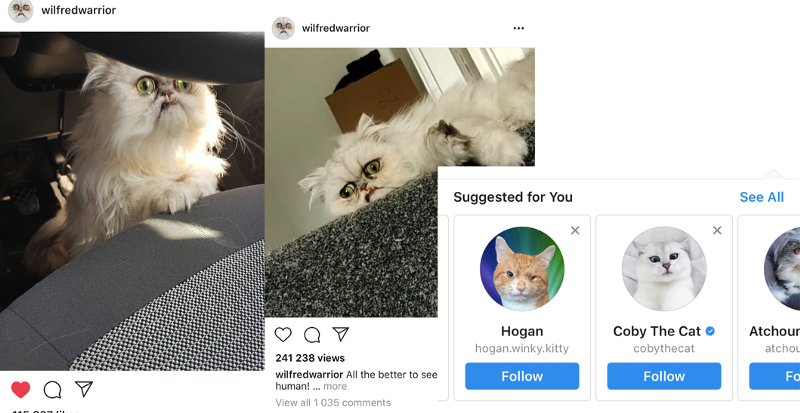Why is it bad when the Internet knows everything about you?
Hi, Habr! I bring to your attention a translation of the article "The Dangers of Overpersonalization" by Kim Flaherty and Kate Moran.
Bottom line: Excessive personalization of content leads to a homogeneous and indifferent user perception of information and can cause fatigue from your product as a whole.

In many ways, personalization of information benefits mankind. Internet users are so overwhelmed with the most diverse content that filtering by popularity and providing the user with only the information of interest can significantly reduce user efforts and make work on the Internet much more productive and more convenient.
However, many users know that their every interaction in the network is monitored and analyzed. All this data is marked and segmented to create individual profiles and collections for each client (stories, products, advertising and news, movies, games ...). But in what cases is excessive personalization becoming a problem?
In our study, we found several shortcomings of excessively personalizing information. In particular, one of the problems is that the user, by selecting categories within which he wants to receive information, thereby "pushes himself into a corner" and begins to receive only the information that he has determined for himself in advance. However, people are often multifaceted and tend to change their tastes over time and under the influence of various circumstances. A system focused on one particular user risks becoming boring or even annoying for another.
Accuracy or relevance
The problem with personalization is built on the balance between the accuracy of the result and its relevance (IR).
Take as an example the search for information.
Accuracy is the percentage of the search results found for the words you specified (what you are really looking for).
Relevance is the percentage of all relevant results that are already known to the search engine (everything you were looking for before this query, additional information about your location, and so on ...).

If we talk about search engines, the ratio of these metrics allows you to get the best result and find exactly what you need at the moment.
Since its inception, the Google search engine has relied not on accuracy, but on the relevance (personalization) of information, which allowed them to stand out among competitors. Search in an almost endless data source should be relevant, and should not at all force us to independently understand every result that could potentially be useful to us.
Similarly, many digital products also prefer relevance over accuracy — trying to make sure that the recommended content is definitely relevant to the user. As a result, they strictly adhere to the information that they already know about the user (topics of interest, content that they liked before, etc.). However, the same strategy, which is great for search engines and the search for the necessary information, is absolutely not suitable for building a feed on social networks.
For example, let's imagine a user who is viewing a photo in a conditional service. Our user has two main interests - he equally loves cats and dogs.

In our invented service 100 posts with photos of cats and 100 posts with photos of dogs (plus thousands of posts on other topics). Most likely, the user would like to see any of the 200 publications about cats or dogs, but as soon as he responds positively to the post with the cat, the system will build recommendations for the user, without any signs that he loves dogs. As a result, the user will receive a tape, consisting entirely of photographs of cats.

We see that the user gets a very accurate, highly relevant set of posts, but by doing so we deprive him of diversity. Ideally, he would like to see posts about cats and dogs, but the application does not use its full potential and the user sooner or later loses interest in the content being viewed. Moreover, perhaps this user would have thought that the platypus is the cutest animals on earth if he ever saw them. However, a bunch of photos of platypuses in the application will never be shown to our user.

Over-personalization is dangerous for both organizations and users:
- Users again and again see the same type of content, with virtually no opportunity to expand their horizons and interests;
- Companies receive insufficient information and, thus, are not well aware of their users.
This approach is focused on users as one-dimensional characters, and not on the complex and multifaceted personalities that we are with you.
Homogeneous experience
We have seen above that excessive personalization can lead to negative experiences (in the context of a social network) and that it can satisfy only some of the many interests of the user. But what do the users themselves think about this? How do they react to over-personalization?
Fatigue condition
We [the authors] are starting to get bored, flipping through the Instagram feed. All that we see is cats and decorations. Yes, we both love cats and jewelry, and Instagram certainly took that into account. Our interactions with these types of posts created a snowball effect. Most of the content that is algorithmically advertised to us by the platform fits into these categories, so over time our personal pages begin to be saturated with the same uniform content that we see in others. (Yes, Instagram has a special Discover tab, where you can find something new for yourself ... But to go to this tab, a person needs to make an effort over himself, and the content from this tab is not related to your main ribbon).

Participants in our study expressed similar feelings; in some cases, excessive personalization leads to the fact that users lose interest in the application or refuse it altogether.
Some research participants in the US were browsing through Instagram and Facebook, even without reading posts, explaining this by the lack of new and interesting materials in their feeds.
"It's boring".
"The routine ritual in the morning."
“I constantly see the same people on Facebook; there is no doubt about it. ”
One girl even noticed that due to the fact that the content in her stream became boring, she continued to scroll the ribbon in search of something interesting: “Today I don’t find anything interesting on Facebook, but what’s funny is that I’ll continue to twist the ribbon until until I find something interesting; this is particularly addictive. ”
This behavior is related to the Vortex phenomenon, which means that people feel drawn into the online world almost against their will with the help of sticky design methods (for example, continuous streams of content provided by social networks). Users strive to get an emotional return from good content. In these cases, the phone turns into a mini-gaming machine: they pull the lever, encounter dozens of failures and continue to play in the hope of finally winning.

Several participants in our study in China for the Life Online project reported that they were first actively using TikTok (a social network for sharing music and video): the content on the platform was really exciting. Some users said that they sat and watched the video for hours on the span. But then at one point they got bored. Everything began to look the same, so they stopped using the app. “This is pretty much the same content being published over and over. I have no particular desire to keep looking at this. ”Said one of the study participants.

Content fatigue due to excessive personalization does not exist only in social networks. In our study of recommendation systems, an Amazon user noted that she meets outdated and boring product recommendations in the “Recommendations for You” section.
Looking through the product line, she commented: “Some of these things, for example, Argan oil, I looked through several years ago ... So this is not a very relevant recommendation for me now [...] Over the course of several years, my tastes have probably changed.
For example, I bought lactic acid 4 years ago and I do not think that this recommendation is still relevant for me. "

This example shows how an analysis of user interests in a narrow segment can lead to recommendations becoming boring and irrelevant. As our participant noted, interests tend to change over time. In addition, Amazon misses the opportunity to explore the current interests of customers and recommend them new products.
Another user viewing the Explore section at Amazon added a squid product to the basket ... “I really liked squid, and Amazon began to show me more things with squid [...], that's the problem if I search for new interesting things things, my tape will be almost completely filled with squid. I don't want him [Amazon] to offer only squid, although I think squid is really very cool. ”
It works about the same as if you were a child, and told your mom that you love cats. After that, for every Christmas, you would receive gifts that are cat-shaped.

To summarize ... personalized content can affect user interaction with your application, and bore your users ... and you will not learn more information about your users and will not be able to adapt the application to their new expectations.
Replicable content
The same type of content that you see on social networks, such as TikTok and Instagram, is aggravated by the fact that other users of the community create similar and duplicate content just to get into the output of the algorithm in pursuit of popularity.

In Instagram, there is a profile that defines the replicated content and similar techniques that users follow one after another. For example, photos with the same type of landscape and the same point of view or viewing angle ... Although the photos are taken at different times and by different users, they all look alike. ( @insta_repeat )

It even got to the point that one Chinese user intentionally plans to reproduce some popular images on his upcoming trip to Paris. The girl looked at posts in the Redbook, which were made by other users in Paris. The photos inspired her to visit the same places, and she intends to recreate her favorite posts in her own account.
“I want to imitate travels from popular blogs that I have seen on the Internet, - I will be photographed in the same place and in the same pose, from the same angle.”


Echo camera
Another symptom of superpersonal, homogeneous experience.
The echo chamber is a situation created by forcefully targeted content that “eats” into our beliefs and is supported by what we see in our tape the same thing. The echo chamber effect fuels social polarization between people.
For example, on Facebook, people love to interact with the content that they like (like, share with friends ...). Thus, over time, when the platform identifies the interests of the user, the algorithm begins to show only those messages that are specifically for this user (or group of users). In this case, creating a world in which the user consumes only those types of messages that reinforce his beliefs and interests. People no longer see messages that challenge their beliefs or broaden their points of view.

If each statement is aimed at confirming our interests, we miss the opportunity to learn about other experiences. Result: in real life, people are divided as clearly as in the virtual world.
Before we began to receive targeted content on the web, our communication consisted of discussing the same news and thus created a sense of community. Our worldview was shaped by reading and perceiving the same information as other people and as a result, people were more cohesive. In March 2017, The New York Times announced that it would begin experimenting with personalized news for its online readers. This news caused concern to many. People complained that they could not share the same news and discuss the same stories that their friends and relatives had read.

The dark side of personalization
Personalization can easily scare you in some situations. Although most consumers know that their actions are being monitored in order to provide them with the best recommendations, this can be a problem if one of your actions can cause a wave of spam to your email or phone number.

We asked some of the participants in our Life Online research how companies determine which ads to show to users? Most users know that ads and other content have been personalized based on previous user actions. When a person searched for something in a search engine and then suddenly continued to see the result of his search across the entire network.
For example, one Chinese participant in our survey told us: “If I look at the toilets on Taobao, there will be information about household appliances everywhere. The disadvantage of this is that if I have already bought some thing, advertising will still appear. And it will be bitter for me if I see a discount on a product I recently bought. ”

Most of our participants did not know exactly how sites convey information about the actions of visitors among themselves. Sometimes there were situations when it really seemed that personalized content violated the boundaries of what they thought the site or devices should know about the user. This practice seemed especially creepy.
For example, one of the participants in our research in China commented that she understands why on the phone she receives advertising related to mobile applications, but when she uses a computer and receives information related to her recent activity on a mobile phone, it can be a great shock to her. It also scares users that Facebook seems to know and use data from recent user requests to Amazon and Google.
(Although we are not against a unified system of user interfaces, sometimes it is still worth limiting user expectations and protecting him from an all-knowing backend system.)
People are also intimidated by information tightly tied to confidential user information. For example, information about food or pregnancy, funeral preparations, or prescriptions for treating exotic medical diseases shown to the user can cause strong emotional reactions if they are shown out of context and relate directly to the user. Some online interactions should be kept confidential or should be treated with caution.
How to avoid over-personalization
Now that we have the technical ability to monitor, analyze and personalize the user experience in our products to the smallest detail, it becomes clear that there is a barrier between the desire for personalization and the weighty weaknesses that arise from over-personalization. Perhaps it is time to take a step back and evaluate our capabilities. Based on the pain points observed in our study, we have compiled several recommendations that companies must take into account in order to prevent errors related to personalization of information:
- Expand the boundaries of consciousness. Consider expanding your segments to provide a certain level of personalization, but still provide a variety of content for the user. The New York Times frequently asked personalization questions page indicated that the organization seeks to strike a balance between the provision of personalized stories and shared content.
- Shake and mix. Do not rely too much on the known interests of your customers. Create content strategies that purposefully introduce untargeted content into your users' feeds. Consider striking a balance between targeted content and the introduction of new or popular products that go beyond the user's interests. Also consider how these messages are delivered to the end user. Channels, SMS and e-mail are probably more suitable for informing about important events, while social networks can be better suited to mixing information about your product, because in these sources users are more open to view and discover new and unique information. When forming general materials, try to make a variety of content that, once in the tape of a person not from your target audience, will be able to attract additional attention.
- Do not use common algorithms. Customize ads for each post from scratch. Some topics may be more sensitive than others. Determine which target content matches your theme, and see how you personalize it again. Perhaps it is not worth being conservative in the approach to these issues.
- Give customers the opportunity to respond. Users should be able to indicate whether the content is really an accurate target hit or not.
Give customers a sense of control over personalization.
')
Source: https://habr.com/ru/post/443430/
All Articles